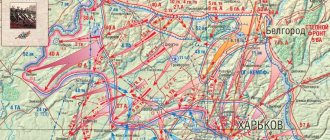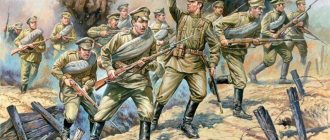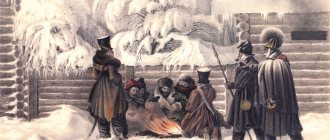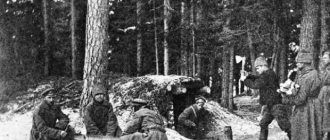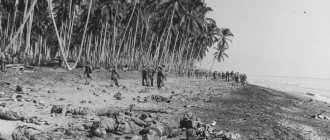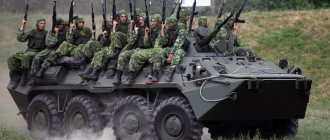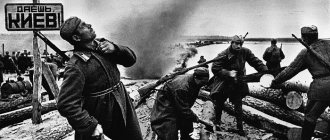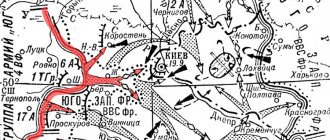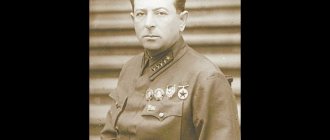Positions of the parties
In preparation for battle, the German First Corps took up a position approximately 10 km northeast of the city of Gumbinnen. To the north, in the Tilsit area, there were 1 Corps, the Koenigsberg garrison, 2 Landwehr Brigade and 1 Cavalry Division.
Before the battle
The Battle of Gumbinen-Goldap, as a rule, is considered by historians as an independent battle. However, you need to understand that the events of August 20, 1914 were preceded by other events, which also left their mark on the subsequent successes of the Russian army. In particular, it is very important to consider the events of August 19, during which 2 events occurred that had a significant impact on the further course:
- In the Kaushen area, the Russian cavalry of Khan Nakhichevan clashed with the second Landwehr brigade. As a result of the battle, the German brigade was forced to retreat across the Easter River. During the retreat, the brigade lost contact with the first corps and did not take part in the battle on August 20. The Russian cavalry corps also retreated back and did not take part in the battle of August 20.
- The Russian 28th Army stumbled upon German positions in the Pokalnishken-Nibudshen area. The positions were well fortified, so a local battle forced the Russian army to retreat.
Progress of the battle
The Battle of Gumbinen-Goldap began on August 20, 1914. At dawn, German artillery began preparing for an offensive. Most of the artillery fire fell on the positions of the 28th Russian Infantry Division. The preparations lasted about an hour, after which the German army went on the offensive.
Initially, the German army had the advantage, however, very soon counterattacks by the Russian army forced the German 1st Army Corps to flee, and the 17th Corps, led by Mackensen, came under severe rifle and artillery fire.
Nevertheless, the German offensive managed to defeat the 28th Russian infantry division, however, this was achieved through enormous efforts and it was not possible to continue the offensive. In the south, Mackensen's corps, under heavy artillery fire, was forced to retreat by the end of the day./
Thus, in the Battle of Gumbinnen it is necessary to highlight 2 main features:
- In the center, the 1st German Corps achieved success against the 28th Infantry Division of the Russian Army.
- The 12th German Corps in the south was defeated and forced to retreat.
It would seem that we can talk about approximate equality, but due to an unfavorable situation and errors in management, the German army found itself in an extremely dangerous situation.
The German plan to destroy the Russian army at Gumbinen was a complete defeat. The battle ended at approximately 3 o'clock in the afternoon, and the German army was unable to complete its tasks. Moreover, as a result of the retreat of most of the German troops, the entire question of the defense of East Prussia was jeopardized. In total, Germany lost about 8 thousand people killed and 6 thousand people captured in the battle. It is characteristic that the total losses of Russia amounted to about 16 thousand people. Thus, despite the victory, the human losses of the Russian army were significant.
Battle Map
By the end of August 19, the 1st Russian Army of General P.K. von Rennenkampf, during a three-day offensive, reached Goldap and Gumbinnen. The next day, a day was planned to give the soldiers a rest, and the rear troops to establish supplies and communications, but the commander of the 8th German Army, M. von Prittwitz, had other plans for August 20: fearing an early invasion of the 2nd Russian Army, he decided to defeat the troops Rennenkampf.
The first clashes on individual sections of the front began the day before, but the battle itself, which went down in history as the Gumbinnensky (or Gumbinnen-Goldapsky), unfolded on August 20. Directly on the battlefield (given that part of the 1st Army did not take part in it at all), the Germans had superiority both in manpower and in the number of guns.
In tactical terms, this battle can hardly be fully considered an asset for the Russian army. From the very morning, the 1st German Corps of General G. Francois attacked our right flank, or rather, the 28th Infantry Division of General N.A. Lashkevich. On this section of the front, the enemy had more than double superiority in manpower, and quadruple superiority in artillery [1] . Moreover, our division was exhausted by the events of August 19, when in the evening the 109th regiment was defeated.
Heavy fighting began in the early morning along the entire front of Lashkevich’s units. By 8 o'clock the bypass of the right flank was determined. Here, in the Ushballen , three battalions of the 111th Infantry Regiment (with 8 machine guns and 24 guns) were defending, attacked by the Germans in the morning. At 10 o'clock the Germans finally broke our defenses and the regiment began to retreat. Then the division chief gave a strict order: “Not an inch back!” This resulted in the most valiant companies being surrounded and killed, slowing down the enemy attack. By noon, the Germans occupied Ushballen, Brakupenen and developed a further offensive, and General N.A. Lashkevich continued to send telegrams for help to the neighboring 29th Division, which itself was at that time engaged in repelling the enemy offensive, to no avail.
But the Germans were unable to develop their success. In the afternoon the 28th Division launched a counterattack and drove the enemy out of Brakupenen . The units of the 1st German Division withdrawing from here came under their own artillery fire and retreated in disarray. As a result, the 1st Corps was exhausted, control was disrupted and the troops could no longer advance. But Lashkevich’s units were not in the best position: they continued to retreat randomly. In two days of fighting, the 28th Division suffered losses of 7,000 men and 8 guns. The neighboring 29th Russian Infantry Division of General A.N. Rosenschild-Paulina was able to repel all attacks, but the withdrawal of N.A.’s troops. Lashkevich forced her to retreat by the end of the day in order to secure her flank.
At the same time, the 1st German Cavalry Division raided the rear of the Russian army, bypassing its right flank, reached Stallupenen, where it encountered infantry, and therefore retreated to Pilkallen, sowing panic in the rear of the 28th division and disorganizing control. Thus, almost the entire headquarters of the 1st Army was captured. All this happened due to the absence of the cavalry of Nakhichevan and Oranovsky on the right flank, which, after the successful battle of Kaushensky on August 19, retreated to the rear and stood for the rest of the next day.
A rather unclear situation also developed on the left flank of the 1st Army. The 30th Infantry Division under the command of General E. Kolyankovsky moved to the Plavishken-Gavaiten front and soon became involved in a heavy battle with the 1st Reserve Corps of General O. von Below. Thus, the left column (2nd brigade) was attacked in the Mazutchen . Here the regiments came under artillery fire, one of the commanders was killed, which caused disorganization in the department and led to the retreat of some units. However, the commander of the 120th Serpukhov Infantry Regiment, Colonel Vladimir Cheremisov , was not at a loss, who, under heavy fire, stopped the confused regiment and returned it to its original place, which made it possible to delay the enemy’s onslaught and gain time to bring neighboring units to the position. [2]
Heavy fighting broke out on the front of the neighboring 1st brigade in the area of the villages of Kurnen and Plavishken. The Germans opened heavy fire from the direction of the village of Gavayten , and then went on the offensive. During these battles, the chief of staff of the division, Colonel Georgy Tikhmenev [3] , who, while under fire, put the retreating units in order and directed them into battle, led the artillery during the shelling of Kurnen, and then gave the order to the neighboring 160th Infantry Regiment. , located in Kiauten and opened fire on Gawaiten, to come to the aid [4] . It is interesting to note that at the same time, a request for assistance to the 160th regiment came from the 40th division. The regiment commander made a “Solomon decision” and did not provide assistance to either one, but the matter was decided by Colonel Vinogradov , who, together with his battalion, went on the attack in order to support the 30th division.
Describing all these events, one cannot fail to note the heroism of one of the battalions of the 118th regiment under the command of Lieutenant Colonel Vladislav Zakrzhevsky , who went into battle under heavy fire, and when faced with superior enemy forces southeast of the village of Kurnenen, occupied one of the heights. At this time, the enemy developed an attack, as a result of which this position was in his rear, which Zakrzhevsky, who had not retreated, took advantage of: he opened fire and stopped the enemy’s advance. Soon two battalions of the 117th Yaroslavl Infantry Regiment arrived at the battlefield, and then they managed to push the enemy back. V. Zakrzhevsky himself was awarded the Order of St. George 4th Art.
Here, the staff captain of the 118th Shuisky Infantry Regiment, Boris Pleschinsky, (for which he was awarded the same award). As stated in the award order: “Under strong rifle and shrapnel fire from the enemy, he quickly rushed forward with machine guns and took up a position, opened destructive fire, and then, despite the fact that he was wounded, he himself dragged the machine guns up the mountain into the enemy’s flank and fired at him forced us to clear the trenches, which our advanced troops took advantage of and drove the enemy back to the village. Gowaiten"
The battle lasted until the evening, neither side was able to gain the upper hand, and therefore everyone spent the night in positions. The next morning the Russians discovered that the enemy had retreated. The Germans retreated hastily, as can be judged by the gun limbers found in Gavaiten, as well as the numerous seriously and lightly wounded. General O. von Below himself reported on his success. It must be admitted that despite the advantage, the Germans did not achieve a decisive victory, only by pushing back the enemy, although if the battle had continued on August 21, they would have likely gained the upper hand.
But the most stubborn battles took place in the center, where from the very morning the 3rd Russian Corps of General N.A. Epanchina withstood the attacks of the troops of the 17th German Corps of General A. von Mackensen. At the front of the 25th division of General P.I. Bulgakov, defensive battles were fought all day, in some areas the Russians launched a counterattack. Thus, the 97th Regiment was able to move forward and push three ersatzbattalions behind the Lasdilenen-Sadveichen line. It was probably at this time that staff captain Viktor Kamensky II , for which he was awarded the Order of St. George 4th Art. Approaching the barbed wire and seeing the company's hesitation, he rushed forward to cut the wire in order to ensure further advance. And this despite enemy fire! The example of the company commander immediately raised the spirit of the lower ranks, who ran forward and, cutting the wire fence, opened the way, which contributed to the overall success of the attack, during which Kamensky himself was seriously wounded in the head by a shell fragment [5] .
However, not everything went so smoothly on the left flank, where some units retreated, respectively exposing the flank of the 27th Division. However, her boss, General A.M.
Adaridi , sent an artillery division and two battalions here. At the same time, General Bulgakov decided to use reserves by mid-day. As a result, all these actions nullified the Germans’ successes and forced them to retreat (and they managed to free many of our prisoners).
In telling about all this, we cannot forget ID. senior adjutant of the headquarters of the 25th division, Captain Vladimir Baranovsky , who was sent to the forward units to clarify the situation and with orders. Approaching the village of Ionastal, he personally stopped the retreating units and restored order in them, and subsequently oriented the commanders in the general position, directed the units forward and arranged for the artillery of the 25th artillery brigade division to fire. For these actions he was awarded the Arms of St. George.
Heavy and decisive fighting from early morning took place on the front of the 27th Infantry Division, defending in the Mattiskemen -Varschlegen area. The Germans launched attacks several times, covering the Russian units with heavy fire, but they were never able to dislodge us from our positions. Accurate fire forced the enemy chains to lie down. At approximately 14.30. At the front of the 108th regiment, an enemy division was seen moving into an open position, which was shot at point-blank range by the 1st division (27th artillery brigade) under the command of Alexander Ilyasevich (for this he received the St. George weapon). And somewhere at 15.00. The Germans launched a final attack, also unsuccessful. The matter was decided by our counterattack, which overthrew von Mackensen's units and forced them to retreat. Heavy losses (over 6,000 people) and a huge expenditure of artillery (only one division fired 10,000 shells) [6] forced the command to order a stop. The 27th Russian Division, during a short pursuit, took 12 guns, 25 ammunition boxes, 3 serviceable and 10 broken machine guns, 2,000 rifles and about 1,000 prisoners. Enemy losses amounted to 8,000 people.
In the evening, M. von Prittwitz, having received a message about the difficult situation at the front and that the 2nd Russian Army of General A.V. Samsonova had already crossed the border, suddenly panicked and ordered a retreat. Its central corps was defeated, the troops on the left flank were severely exhausted and could not advance. The total losses in killed, wounded and prisoners exceeded 14,000 people. In contrast, Army Quartermaster Grunert and Chief of Operations Department M. Hoffmann argued that the situation was favorable, and if the battle continued, the enemy would be defeated. But M. von Prittwitz insisted on withdrawing.
However, P.K. von Rennenkampf did not pursue. He immediately canceled the first orders to drive the enemy, for which he was criticized by a number of historians. This can hardly be considered justified, because the troops were tired, also suffered losses (more than 18,000 people), and the rear was not established. It is known that from victory to defeat there is only one step, and none of the Russian generals could be sure of the success of the pursuit, especially in view of the consumption of ammunition, as well as the difficult or ambiguous position of most infantry divisions. So, given the situation, it is unlikely that Russian troops could have any success from continuing the attack. Although the Russian cavalry rested in the rear on August 20 and could appear on the battlefield the next day, it is unlikely that it would have been effective. Having difficulty coping with the Landswehr brigade in the battle on August 19, it is unlikely that the same regiments could do anything with such a serious enemy as the corps of G. von Francois. Moreover, the Battle of Kaushen on August 19 casts doubt on the ability of Khan of Nakhichevan to use his maneuver advantage. The experience of the First World War generally shows the ineffectiveness of large cavalry formations, especially in battles against infantry.
Assessing the battle, one should first of all note the endurance of the Russian corps and division commanders, primarily N.A. Epanchin (former director of the Corps of Pages, son of Admiral Alexei Pavlovich) and A. Adaridi (27th Division), thanks to whom the victory was won. As for the army headquarters, because of the enemy cavalry raid, it practically did not take part in the command and control of the troops. It is impossible not to note the criminal behavior of our cavalry on the right flank, which had no energetic leaders and spent the entire day inactive.
This battle demonstrated the training of Russian soldiers and officers, especially on the front of the 3rd Corps (which Rennenkampf himself commanded before Epanchin), and the effectiveness of Russian artillery, which, firing from closed positions (unlike German), was particularly accurate, hitting the enemy great damage. However, one cannot help but admit the powerlessness of our 76-mm cannon against a well-entrenched enemy, as is clear from one report from General Lashkevich to corps headquarters [7] . Our soldiers also turned out to be accurate in rifle fire.
As a result, we can conclude that the German plan to break up the Russians piece by piece failed. The 8th Army retreated, and Russian successes panicked General Prittwitz, who was soon removed from command. It should be noted that the further successes of the Russian troops (the advance of Rennenkampf, the offensive of the 2nd Army of General Samsonov, who defeated the 20th Corps of General Scholz on August 23-24) had a heavy impact on the German High Command. In view of the successes on the western front during the Border Battle, it decided to transfer two corps and a reserve cavalry division (freed up after the fall of the Namur fortress) to the east to stop the Russian advance. This contributed to the victory of the Anglo-French troops on the Marne, when the German offensive was stopped.
Konstantin Pakhalyuk
[1] Combat operations of an infantry division. Collection of historical examples / Ed. ON THE. Talensky. M, 1941. P. 32
[2] RGVIA F. 2106. Op.2. D. 1. L. 224
[3] Subsequently he made a good career. He was the commander of several regiments, then promoted to the rank of major general, then he was the chief of staff of the 45th division and the 13th corps, and after the February revolution he was given command of the 17th infantry division.
[4] Ibid. L. 227
[5] Ibid. L. 12 about
[6] Budberg A. Gumbinnen – a forgotten day of Russian glory. San Francisco, b.g. P. 7.
[7] Yamanov A.A. Meeting engagement. M., 1959. P. 164.
Dear visitors! The site does not allow users to register and comment on articles. But in order for comments to be visible under articles from previous years, a module responsible for the commenting function has been left. Since the module is saved, you see this message.
JComments
Aftermath of the battle
Speaking about the Battle of Gumbinen, it is very important to note the role of the Russian infantry. It was the infantry and artillery that managed to thwart the German plan to destroy the Russian army. At the same time, 5.5 cavalry divisions were located just a few kilometers from the right flank of the army, where the fighting took place, but did not take part in the battle, since they were resting from the local battle on August 19...
In the battle itself, it is important to highlight the following consequences:
- Traditionally, at the beginning of the First World War, the Russian army saved France with incredible efforts. The Battle of Gumbinnen was no exception. As a result of the breakthrough in East Prussia, Germany was forced to withdraw 2 army corps and 1 cavalry division from the French front and transfer them to the Russian front. It is very important that these were corps from the strike force.
- The Russian army demonstrated the ability to conduct successful military operations on a wide front, so in the future new German military formations were sent specifically to the eastern front.
- The German General Staff appointed a new command of the eastern front, which insisted on shifting the main attack to the eastern front. Thus, starting in August 1914, the main military operations for Germany shifted from the French to the Russian front.
The global consequences of the military battle are discussed above, however, it is important to note that despite the victory and advancement of the Russian army, this did not lead to significant changes. The fact is that the retreat of the German army allowed pursuit with the possibility of complete destruction of the 8th German army. However, this was not done, and the moment was lost. This was largely due to the fault of General Rennenkampf, who after the battle gave the army 2 days off, starting the pursuit of the enemy only on August 23.
German command plan
The Germans had a superficial understanding of the Russian army. They knew about the shortage of railways in the Russian Empire, from which they concluded that the enemy army was slowly mobilizing. The Schlieffen plan allocated 42 days for the destruction of France. After the victory of the Western Front, 90% of the troops were supposed to move to the Eastern direction.
In the event of a Russian attack, the German 8th Army was supposed to hold back their advance. She was faced with the following tasks:
- Defend the borders of East Prussia.
- Strengthen the offensive of the Austro-Hungarian troops in the area of the Western Bug and Vistula.
- Hold the Lower Vistula, a strategically important line for future offensive operations.
The command of the 8th Army was free to make decisions. You were allowed to act according to the situation.
